Growth: thoughts on metrics
30 de May, 2022Delivery date is another source of conflict between business and tech
13 de June, 2022At some point during the growth phase of your product, it may be helpful to create its vision and strategy. These tools will greatly help you in the decisions about what the future of your product will be. For this reason, I will explain in this chapter what is product vision and strategy and how to create them.
What is a product vision and why do we need it?
The same way your kids wants to be something (doctors, lawyers, engineers, etc.) when they grow up, the product vision is what you want your product to be when it grows up. Product vision is how you envision your product in the future. It is the reason why the product exists. It is what should guide all decisions regarding this product. It gives the context for the product development team to make decisions about what to prioritize in relation to the product.
As I mentioned earlier when defining product management as the function responsible for building the connection between the company’s strategic goals and the problems and needs of clients, a product must at the same time meet the strategic objectives that the product owner has for this product while it solves problems and needs of its users. There you have the two elements needed to make your product vision.
Creating the Product Vision
The vision of the product will be created by bringing together these two elements, understanding the objectives of the product owner and the problems and needs of the user of the product. So the first step in creating your product vision is to be clear about what the product owner’s goals are.
For example, a bank creating an internet banking system may have the objective to reduce the need for in-person, face-to-face interactions. A clinical lab that creates an app for users to view their clinical exam results may have as its objective to lower the operational costs of handling and sending results.
Then you need to understand the problems and needs that this product will solve for your users, in which context these problems and needs happen and what motivates these users have to see their problem or need to be solved.
A nice tool to understand the user is the empathy map.
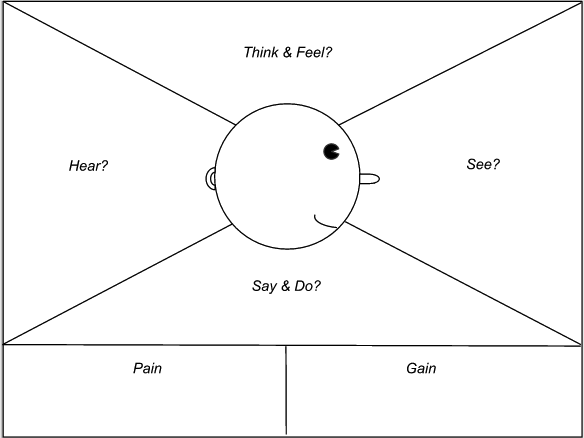
This map helps to focus on the different perceptions that the user may have:
- See? – What does your user see? How is the environment where it uses the product? What does the market offer?
- Listen? – What does your user listen to? What do your friends tell you about your product? What does his boss say? What do the influencers say?
- What do you say and do? – What does your user say and do in relation to your product? What does he talk about with friends and on social networks? What can he do with your product?
- Think and Feel? – What does your user think and feel when using your product?
- Pain? – What are the main pains, fears, frustrations, and obstacles that your user encounters?
- Gain – What are the key winnings, desires, and needs that your user expects to have when using your product?
Another useful tool is the persona, which represents a group of users with similar patterns of behavior, attitudes, and motivations in terms of purchasing decisions, use of technologies or products, lifestyle, etc.
The personas are used to:
- Know and understand customers and users of products and services;
- Bring the user to the project focus;
Make design decisions more human and less abstract.
The following figure shows how to build a persona:
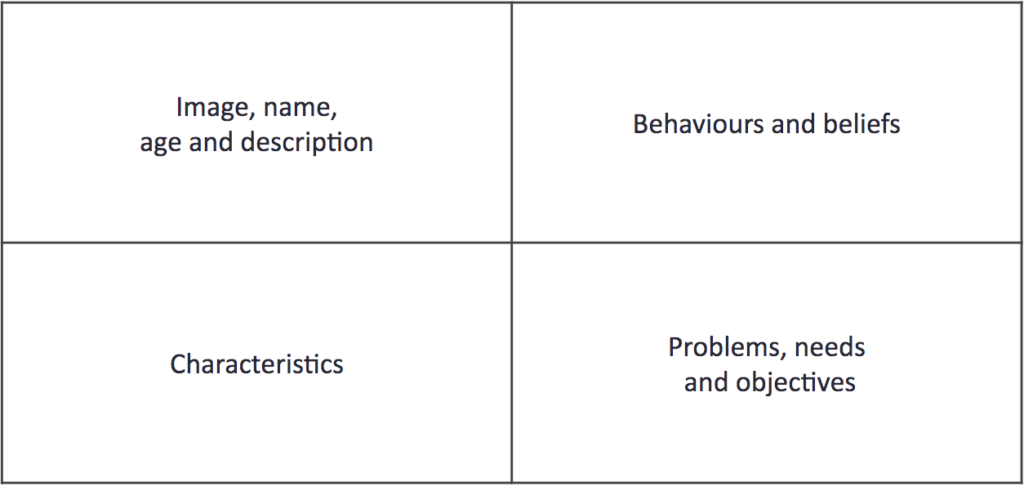
The first step is to define a name and some characteristics of that persona. This helps in conversations about the product. In the name, it’s nice to already give a hint of the main characteristic. For example, Maria, the cool girl, or Michelle, the busy one.
If you are making a product for Michelle, the busy, and want to insert a new feature, one question that comes to mind is: “Will Michelle, the busy one, be able to use this feature? Will she find it useful enough to find time to learn how to use it?”
Beyond the name and basic characteristics, it is also important to describe your behaviors and your problems. The following examples will make the concept of persona clearer.
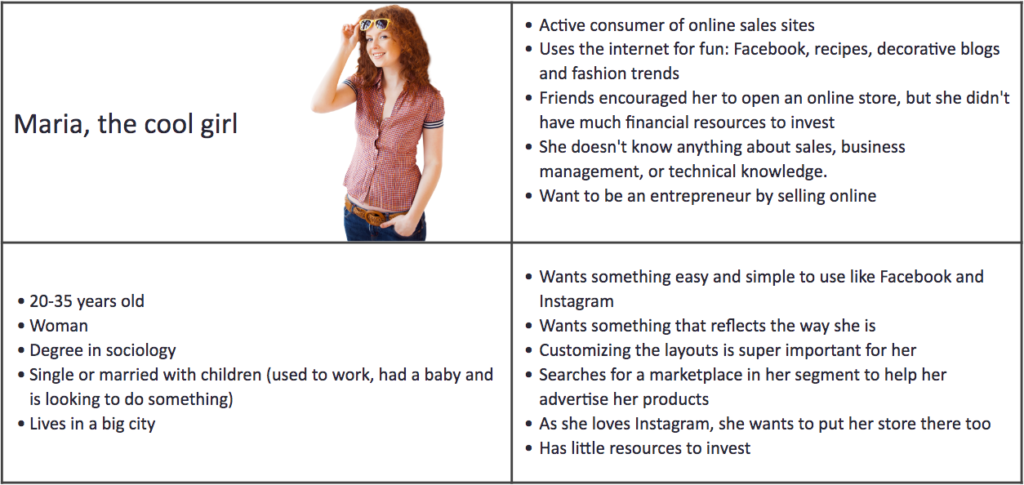
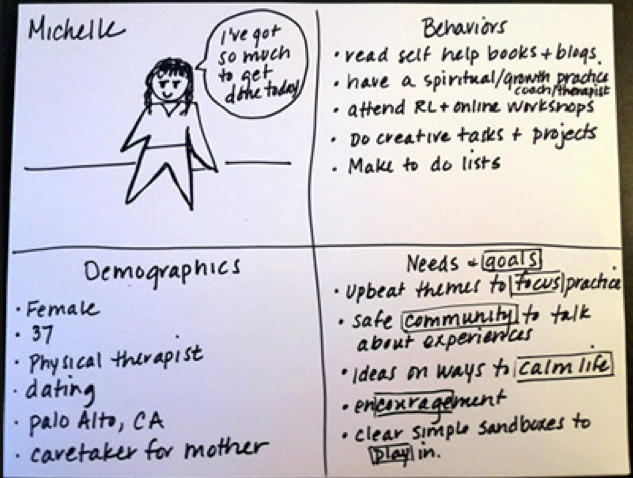
Maria, the cool girl is one of the personas that we used at Locaweb. Given the different products that we have in our portfolio, we ended up building eight personas. However, for each product in our portfolio, we had no more than 4 personas, being one of them the primary persona for that product, i.e, for whom all decisions about the product were taken.
As part of understanding the problem or need that your user expects to be solved by your product, it is very important that you map out the alternatives that exist today for her to have that problem or need to be solved. In the case of commercial products, they are the competitors. In the case of products that are systems without clear revenue objectives, such as internet banking or the clinical lab system for result visualization, the alternatives are going in person to the bank or the lab, calling the bank by phone, and receiving results by mail, etc.
This alternative mapping is very important to understand how your user deals with her problem or need without your product. How these alternatives are better and in which ones they are worse than the product you manage.
Empathy map, persona, and alternative mapping can and should be created in conjunction with UX, engineering, and product marketing people.
Okay, you already have all the elements to create the vision of your product:
- The objectives of the owner of the product you manage;
- Who the users are and what problems and needs these users expect to solve with your product. Useful tools for this are empathy map, persona, and alternative map.
Remember that to get these elements, the product manager will have to use a lot of empathy to talk to the owner of the product she manages and understand their goals, and to talk to the product users and understand them.
With these elements in hand, you are ready to create your vision, which is nothing more than to make clear these elements. Simple, right? It would be something like this:
(name of software owner) has decided to have this software for (objectives of the software owner to have such software). This software is used by (description of the people who will use the software) that, when using this software, expects to solve (problem or need that the user expects to solve) in a better way than (existing alternatives).
(Include more information about the problem or need, including context and motivation to have it solved).
Please do not copy + paste this text! Create your own product vision, which does not have to be text. It can be a presentation or a video, remembering that the vision of the product is the reason why the product exists. It is what should guide all decisions in relation to it.
As you get your product vision clearer, it is important to circulate it within your company to get input, feedback, and questions. By doing this, you’ll have a chance to complete the product vision as well as get the alignment and buy-in from all stakeholders.
Product Vision examples
Internet banking
Here’s an example of a bank where the owner decided to create an internet banking app so they could decrease the cost of building, staffing, and maintaining physical bank branches:
XYZ Bank has decided to have an internet banking app to reduce the operating costs of bank branches.
This software is used by bank account holders who, when using this software, expect to solve their banking needs (see account balance and report, pay bills, make investments, etc.) in a better way than when they visit the bank’s agencies.
Locaweb’s Email product
During my time at Locaweb we put together the following product vision for Locaweb’s Email product:
Locaweb’s Email product will be the most complete and flexible email solution of the Brazilian market.
Conta Azul’s product vision
We built Conta Azul’s product vision as an image because with the image it was easier to explain all the elements of what we saw as the future of Conta Azul product.
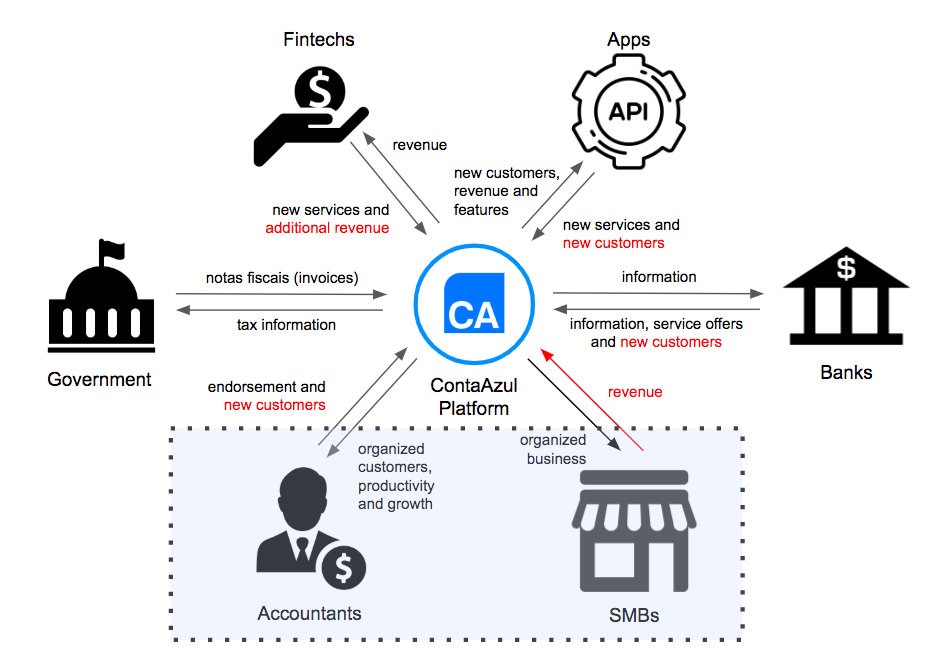
Gympass Product Vision
Again, we preferred an image instead of words. The saying a picture is worth a thousand words has a reason to exist.
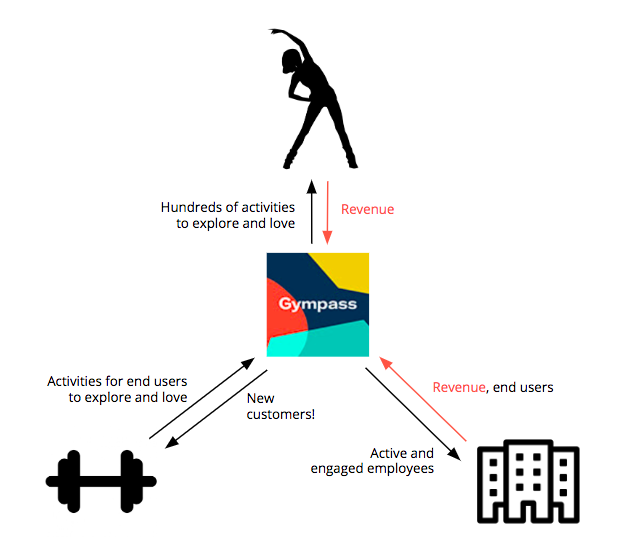
Product Strategy
Once you have defined the product vision, you’ll be probably thinking something along the lines of: “Hum, I think my product is still far from this vision.” Then comes the question “how do I get my product closer to this vision?”. This is where the product strategy comes in, i.e., what steps will be taken to bring the product closer to the vision.
A good tool to help build product strategy is the SWOT analysis, to help you and your team analyze Strengths, Weaknesses, Opportunities, and Threats to your product.
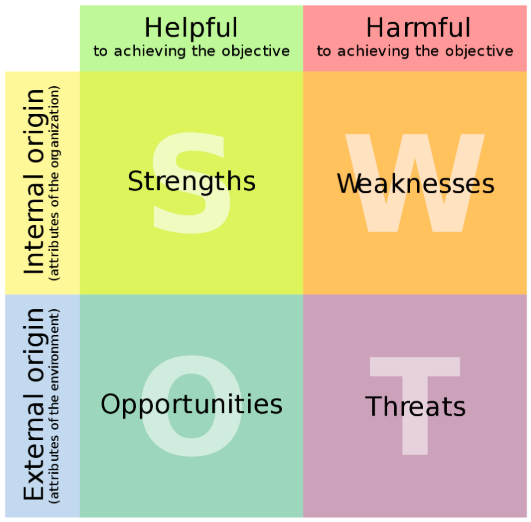
Strengths and weaknesses are internal items (from your product development team, or your company) that you, your team, or your company have some control over, that help or hinder your product from reaching your vision.
Opportunities and threats are external elements to the organization over which the organization has no or minimum control, and which can influence positively or negatively the attainment of the vision of the product.
Filling the SWOT should also be a team effort. The product manager must have one or more sessions together with UX, engineering, and marketing people to build your product SWOT. It is likely that your organization has also done a SWOT analysis for the organization as a whole, which can be a great input for your product SWOT.
SWOT analysis can be tricky, especially in the weaknesses quadrant. It tends to be a big list of items your product doesn’t have yet. My suggestion is to limit all quadrants to 3 items. Having this discipline, you’ll be able to prioritize what are the 3 more important items in each quadrant. Since we have 4 quadrants, you will have a list of 12 items to take care of.
In order to build a more comprehensive SWOT analysis, it is very important to have a good market analysis available. This market analysis should include:
- Competitors: a good view of your product competitors is very important to help you build your product SWOT. Don’t forget to think also about indirect competitors. For instance, an email product has the telephone as an indirect competitor.
- Potential and addressable market: ultimately your product could have the total global population as users or the total number of companies worldwide in a B2B product. However, you most likely designed your product for a subset of these users – or companies. For instance, you designed a delivery product for people who sell things and since it is a delivery product, it is limited to a certain region. This is the potential market. The addressable market is the size of this market that you believe you can reach.
- Market growth: as important as it is to know the size of the market is to know the growth of this market. For instance, the number of landline telephones is close to 1 billion, but this is a shrinking market since there’s a clear movement toward mobile telephones.
- Disruptors: as important as it is to know your competitors is to know what can disrupt your product. For instance, at Locaweb we were seeing a decline in email usage, possibly due to the migration of a part of the communication, which was normally carried out through email, being made by other means such as WhatsApp and Slack. Anyone managing a riding or a delivery product such as Uber, Rappi, and others should be already discussing the impact of autonomous vehicles on their product and business.
Having the SWOT filled up, it’s time to draw the strategy of your product. Product strategy is nothing more than a short, medium, and long-term roadmap.
Long term?
You are certainly thinking that as you use agile methodologies in the product development team, it makes no sense to have a long-term roadmap, not even a medium-term roadmap makes that much sense. In fact, it does, but not in the classic sense of roadmap as a list of features, but instead using the roadmap as a priority list, a list of focus points that must be tackled in a specific order to make the product gets closer to the product vision.
With your product SWOT analysis completed, you should look at each of the items in each of the quadrants, along with the team (UX, engineering and product marketing), and evaluate what impact each item has on the product vision you have created. Are there strengths to be strengthened? If so, which ones should be strengthened first? Are there weaknesses to be tackled? If so, which ones should be tackled first? Are there opportunities to be taken advantage of? If so, which ones should be looked into first? Are there threats to be fought? If so, which ones should be tackled first?
This analysis will help you define the motivations and goals, i.e., the macro themes of your roadmap. Remembering that roadmap = motivation + metrics, which is being popularized with the acronym OKR (Objectives and Key Results). This analysis will help you define what to focus on now and what to leave for later, always aiming ultimately to get closer to your product vision. And that’s the product strategy, the path that you and the product development team will go through to get to the product vision.
Your product evolves, and your vision and strategy too!
An important point is that your product evolves as the team works on it. A lot is learned about the users of the product, their problems, and their needs. New alternatives may appear to help your user solve their problems and needs. The software owner can also revisit their strategic objectives and, consequently, revisit the defined goals for the digital product.
In addition, strengths and weaknesses may change over time, and opportunities and threats may appear or disappear. So, it’s important to understand that neither the vision nor the strategy of the product is written in stone. They can and should be revisited periodically.
My suggestion is that they be revisited annually, or when a relevant event happens, such as when there is a change in the strategic objectives of the company, or when there’s an alternative that solves the problem or need of the user in a different way from the one of its product.
Summing up
With this chapter, we are almost closing the theme of the growth phase of the software product lifecycle. In the next chapter, we will put it all together. Vision, strategy, roadmap, and OKRs.
Product leadership coaching
I’ve been helping several product leaders (CPOs, heads of product, CTOs, CEOs, and tech founders) extract more value and results from their digital products. Check here how I can help you and your company.
Digital Product Management Books
Do you work with digital products? Do you want to know more about how to manage a digital product to increase its chances of success, solve its user’s problems and achieve the company objectives? Check out my Digital Product Management bundle with my 3 books where I share what I learned during my 30+ years of experience in creating and managing digital products:
- Startup Guide: How startups and established companies can create profitable digital products
- Product Management: How to increase the chances of success of your digital product
- Leading Product Development: The art and science of managing product teams
You can also acquire the books individually, by clicking on their titles above.

